Volume 5 | Number 1 | May 2013
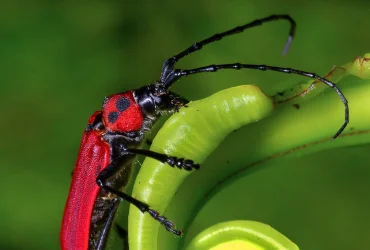 v5i1.103
v5i1.103ISSN: 1800-427X (print)
eISSN: 1800-427X (online)
DOI:10.47605/tapro.v5i1.103
Submitted date: 18 February 2013
Accepted date: 26 April 2013
Published date: 15 June 2013
Pp. 97–98.
A note on bird–habitat relationship in Kirala Kele, Sri Lanka
W.G.K.H. Samarasekara, E.P.S. Chandana* & N.J. de S. Amarasinghe
*Corresponding author. E-mail: epschandana@zoo.ruh.ac.lk
Wetlands and their associated biodiversity are threatened by habitat loss and fragmentation, invasive species, and global climate change. Knowledge of the bird distribution pattern with respect to the habitats is critically important in conservation and management of both birds and their habitats. Hence, an attempt was made to investigate the abundance and diversity of birds associated with selected habitats in the Kirala–Kele (K–K) marshland system with reference to the habitat characters between June 2010 and November 2010. K–K Eco touring zone is one such marshland type wetland situated in Matara, Southern Sri Lanka. It covers an area of about 1,800 ha of natural marsh areas and abandoned paddy fields. In this study K–K bird sanctuary was divided into five sites, differing in water retention and vegetation types, situated along the southwest – northeast trail at least 500 m apart from each other.
Section Editor: Varadarajan Gokula
eISSN: 1800-427X (online)
DOI:10.47605/tapro.v5i1.103
Submitted date: 18 February 2013
Accepted date: 26 April 2013
Published date: 15 June 2013
Pp. 97–98.
A note on bird–habitat relationship in Kirala Kele, Sri Lanka
W.G.K.H. Samarasekara, E.P.S. Chandana* & N.J. de S. Amarasinghe
*Corresponding author. E-mail: epschandana@zoo.ruh.ac.lk
Wetlands and their associated biodiversity are threatened by habitat loss and fragmentation, invasive species, and global climate change. Knowledge of the bird distribution pattern with respect to the habitats is critically important in conservation and management of both birds and their habitats. Hence, an attempt was made to investigate the abundance and diversity of birds associated with selected habitats in the Kirala–Kele (K–K) marshland system with reference to the habitat characters between June 2010 and November 2010. K–K Eco touring zone is one such marshland type wetland situated in Matara, Southern Sri Lanka. It covers an area of about 1,800 ha of natural marsh areas and abandoned paddy fields. In this study K–K bird sanctuary was divided into five sites, differing in water retention and vegetation types, situated along the southwest – northeast trail at least 500 m apart from each other.
Section Editor: Varadarajan Gokula
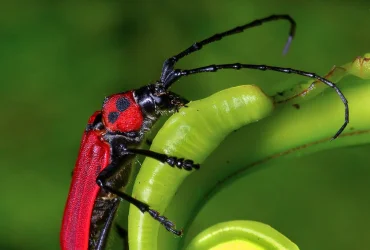 v5i1.102
v5i1.102ISSN: 1800-427X (print)
eISSN: 1800-427X (online)
DOI:10.47605/tapro.v5i1.102
Submitted date: 18 February 2013
Accepted date: 26 April 2013
Published date: 15 June 2013
Pp. 94–96.
Evidence of Saccolaimus saccolaimus (Chiroptera) roosting in a building in Sri Lanka
G.M. Edirisinghe, B.S.A.T.H. Sudasinghe* & Y. Mapatuna
*Corresponding author. E-mail: hsudasinghe@gmail.com
Sri Lanka is a critical area for global biodiversity conservation but rapid land–use changes endanger much of its fauna. Though understudied and under–estimated, bats are a critical component of Sri Lanka’s diversity. Comprising nearly one third of the overall terrestrial mammals of Sri Lanka, bats provide vital ecological and economic services. Sri Lanka has 30 species of bats that belong to 15 genera and seven families. Emballonuridae (Sheath– tailed bats) are widely distributed in the tropical and subtropical regions of the world. In Sri Lanka, there are three species of Emballonurids, Saccolaimus saccolaimus (Temminck, 1838), Taphozous longimanus Hardwicke, 1825 and Taphozous melanopogan Temminck, 1845. Phillips (1980) indicates that Saccolaimus saccolaimus, the Naked–rumped Pouched Bat was once common throughout the lowlands of both dry and the wet zones in Sri Lanka but less common in the highlands. However, now this species is considered to be extremely rare and was not recorded in an extensive five year survey conducted by Yapa & Ratnasooriya (2006) and has been missing from the Sri Lankan bat inventory for 75 years. It was re–discovered in 2011 at an estate in Kurunegala, Wayamba Province roosting in a hollow of a coconut tree. The previous record of this species is from Cheddikulam in 1936.
Section Editor: Judith Eger
eISSN: 1800-427X (online)
DOI:10.47605/tapro.v5i1.102
Submitted date: 18 February 2013
Accepted date: 26 April 2013
Published date: 15 June 2013
Pp. 94–96.
Evidence of Saccolaimus saccolaimus (Chiroptera) roosting in a building in Sri Lanka
G.M. Edirisinghe, B.S.A.T.H. Sudasinghe* & Y. Mapatuna
*Corresponding author. E-mail: hsudasinghe@gmail.com
Sri Lanka is a critical area for global biodiversity conservation but rapid land–use changes endanger much of its fauna. Though understudied and under–estimated, bats are a critical component of Sri Lanka’s diversity. Comprising nearly one third of the overall terrestrial mammals of Sri Lanka, bats provide vital ecological and economic services. Sri Lanka has 30 species of bats that belong to 15 genera and seven families. Emballonuridae (Sheath– tailed bats) are widely distributed in the tropical and subtropical regions of the world. In Sri Lanka, there are three species of Emballonurids, Saccolaimus saccolaimus (Temminck, 1838), Taphozous longimanus Hardwicke, 1825 and Taphozous melanopogan Temminck, 1845. Phillips (1980) indicates that Saccolaimus saccolaimus, the Naked–rumped Pouched Bat was once common throughout the lowlands of both dry and the wet zones in Sri Lanka but less common in the highlands. However, now this species is considered to be extremely rare and was not recorded in an extensive five year survey conducted by Yapa & Ratnasooriya (2006) and has been missing from the Sri Lankan bat inventory for 75 years. It was re–discovered in 2011 at an estate in Kurunegala, Wayamba Province roosting in a hollow of a coconut tree. The previous record of this species is from Cheddikulam in 1936.
Section Editor: Judith Eger
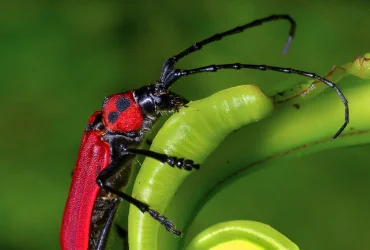 v5i1.101
v5i1.101ISSN: 1800-427X (print)
eISSN: 1800-427X (online)
DOI:10.47605/tapro.v5i1.101
Submitted date: 25 January 2012
Accepted date: 8 March 2013
Published date: 15 June 2013
Pp. 89–93.
Himalayan Yellow–throated Marten (Martes flavigula) in West Bengal, India
J.K. Mallick*
*Corresponding author. E-mail: jayantamallick2007@rediffmail.com
The nominate race of Martes flavigula Boddaert, 1785 (Mammalia: Carnivora: Mustelidae), popularly known as Himalayan Yellow–throated Marten, is the largest among the old world martens and has unique colour blends of black, white, golden–yellow and brown, relatively short fur and a long tail. It is distinguished from eight other recognized races of the species by the absence of a naked area of skin above the planter pad of the hind foot, a large mat of hair between the planter and carpal pads of the forefoot, and by its longer, more luxuriant winter coat. This study was initiated to (1) collect the past and contemporary locality records, (2) describe the natural history and ecology of the species, and (3) assess its conservation status in the hill forests of northern West Bengal, India.
Section Editor: Colin Chapman
eISSN: 1800-427X (online)
DOI:10.47605/tapro.v5i1.101
Submitted date: 25 January 2012
Accepted date: 8 March 2013
Published date: 15 June 2013
Pp. 89–93.
Himalayan Yellow–throated Marten (Martes flavigula) in West Bengal, India
J.K. Mallick*
*Corresponding author. E-mail: jayantamallick2007@rediffmail.com
The nominate race of Martes flavigula Boddaert, 1785 (Mammalia: Carnivora: Mustelidae), popularly known as Himalayan Yellow–throated Marten, is the largest among the old world martens and has unique colour blends of black, white, golden–yellow and brown, relatively short fur and a long tail. It is distinguished from eight other recognized races of the species by the absence of a naked area of skin above the planter pad of the hind foot, a large mat of hair between the planter and carpal pads of the forefoot, and by its longer, more luxuriant winter coat. This study was initiated to (1) collect the past and contemporary locality records, (2) describe the natural history and ecology of the species, and (3) assess its conservation status in the hill forests of northern West Bengal, India.
Section Editor: Colin Chapman
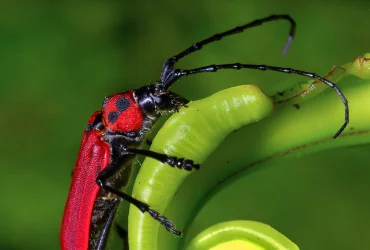 v5i1.100
v5i1.100ISSN: 1800-427X (print)
eISSN: 1800-427X (online)
DOI:10.47605/tapro.v5i1.100
Submitted date: 25 April 2013
Accepted date: 31 May 2013
Published date: 15 June 2013
Pp. 87–88.
Behaviour of Yunnan Giant Flying Squirrel (Petaurista yunnanensis) at a mineral lick in Yunnan, China
H. Lian–Xian* & L. Harding
*Corresponding author. E-mail: lianxian.han@gmail.com
In February 2012 one of us (Han) led an ecotour to Nankang Nature Reserve, west of the Nujiang (Salween) River, Baoshan Prefecture, Yunnan, and saw giant flying squirrels in the evening near the Nature Reserve headquarters. After hearing this, the Nature Reserve rangers began to take evening walks along the highway watching for flying squirrels, eventually discovering a mineral lick. In retrospect, the first observation in 2012 was evidently when the giant flying squirrels were approaching the lick site. On 24 February 2013 we observed the giant flying squirrels for about two hours, from 22:00 hr to midnight, as they approached the lick and returned from it.
Section Editor: Colin P. Groves
eISSN: 1800-427X (online)
DOI:10.47605/tapro.v5i1.100
Submitted date: 25 April 2013
Accepted date: 31 May 2013
Published date: 15 June 2013
Pp. 87–88.
Behaviour of Yunnan Giant Flying Squirrel (Petaurista yunnanensis) at a mineral lick in Yunnan, China
H. Lian–Xian* & L. Harding
*Corresponding author. E-mail: lianxian.han@gmail.com
In February 2012 one of us (Han) led an ecotour to Nankang Nature Reserve, west of the Nujiang (Salween) River, Baoshan Prefecture, Yunnan, and saw giant flying squirrels in the evening near the Nature Reserve headquarters. After hearing this, the Nature Reserve rangers began to take evening walks along the highway watching for flying squirrels, eventually discovering a mineral lick. In retrospect, the first observation in 2012 was evidently when the giant flying squirrels were approaching the lick site. On 24 February 2013 we observed the giant flying squirrels for about two hours, from 22:00 hr to midnight, as they approached the lick and returned from it.
Section Editor: Colin P. Groves
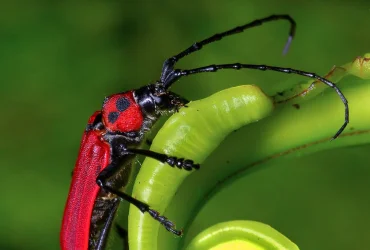 v5i1.99
v5i1.99ISSN: 1800-427X (print)
eISSN: 1800-427X (online)
DOI:10.47605/tapro.v5i1.99
Submitted date: 2 April 2012
Accepted date: 20 April 2013
Published date: 15 June 2013
Pp. 85–86.
The small flying squirrel (Petinomys fuscocapillus) observed after 78 years in Sri Lanka
R.P. Nanayakkara, N. Vishvanath & T.G.T. Kusuminda*
*Corresponding author. E-mail: t.kusuminda@gmail.com
Petinomys fuscocapillus (Kelaart, 1852) is one of two nocturnal Squirrels found in Sri Lanka, and the distribution of the species is only known through a few possible occurrences and museum specimens which were collected nearly hundred years ago. The species was considered to be extinct in India until 1989, when it was rediscovered in a coconut grove in Kerala state, India. In Sri Lanka it was reported by Phillips (1935) from the wet and intermediate zones of the island, and subsequently the occurrence of this species was confirmed by camera trap by Jayasekara et al. (2007) in Sinharaja tropical rain forest. Here we report the first physical examination of this species in Sri Lanka after 78 years, and we publish the first color–photographs. The authors obtained a direct sighting of the Small flying squirrel in the Knuckles Forest Reserve at an elevation of 522 m asl.
Section Editor: Colin P. Groves
eISSN: 1800-427X (online)
DOI:10.47605/tapro.v5i1.99
Submitted date: 2 April 2012
Accepted date: 20 April 2013
Published date: 15 June 2013
Pp. 85–86.
The small flying squirrel (Petinomys fuscocapillus) observed after 78 years in Sri Lanka
R.P. Nanayakkara, N. Vishvanath & T.G.T. Kusuminda*
*Corresponding author. E-mail: t.kusuminda@gmail.com
Petinomys fuscocapillus (Kelaart, 1852) is one of two nocturnal Squirrels found in Sri Lanka, and the distribution of the species is only known through a few possible occurrences and museum specimens which were collected nearly hundred years ago. The species was considered to be extinct in India until 1989, when it was rediscovered in a coconut grove in Kerala state, India. In Sri Lanka it was reported by Phillips (1935) from the wet and intermediate zones of the island, and subsequently the occurrence of this species was confirmed by camera trap by Jayasekara et al. (2007) in Sinharaja tropical rain forest. Here we report the first physical examination of this species in Sri Lanka after 78 years, and we publish the first color–photographs. The authors obtained a direct sighting of the Small flying squirrel in the Knuckles Forest Reserve at an elevation of 522 m asl.
Section Editor: Colin P. Groves
Hubungi Kami
The ultimate aim of the journal is to provide an effective medium for communication of the latest and best scientific information.
Copyright © 2020 Taprobanica. All Rights Reserved
Jasa Pembuatan Website by IKT




